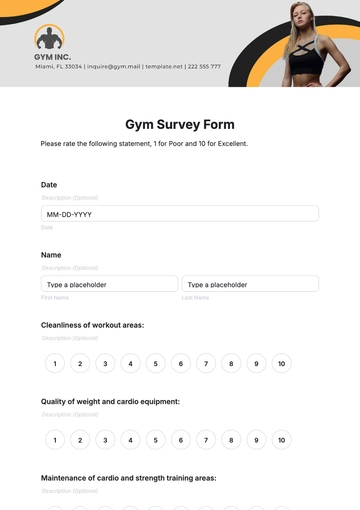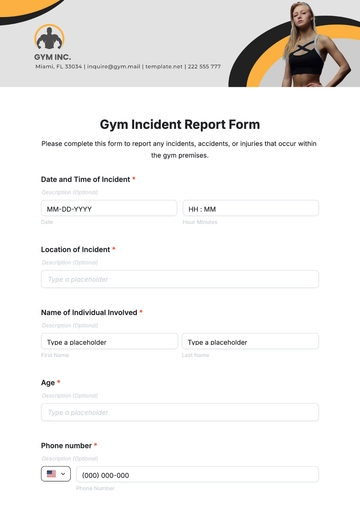Free Gym Marketing Strategy Guide

I. Introduction
The purpose of this Gym Marketing Strategy Guide is to provide a comprehensive framework for increasing our market presence, attracting new members, and retaining existing ones. This guide outlines the strategies and tactics we will use to achieve our marketing objectives. It covers market research, branding, promotional strategies, content creation, customer engagement, and more. By following this guide, we aim to enhance our competitive edge and ensure sustained growth in the highly dynamic fitness industry.
II. Market Research
A. Understanding the Fitness Industry
The fitness industry is experiencing significant growth due to increased awareness of health and wellness. Current trends include the rise of boutique fitness studios, the popularity of digital and at-home workouts, and a growing emphasis on personalized fitness experiences. The global fitness industry is projected to grow at a compound annual growth rate (CAGR) of 7.7% from 2051 to 2058, reaching a market size of $177.0 billion by 2058. This growth presents substantial opportunities for expansion and innovation within our gym.
B. Analyzing the Target Market
Our target market includes diverse demographic segments with varying needs and preferences. Understanding these segments allows us to tailor our offerings and marketing strategies effectively.
Segment | Age Range | Key Needs and Preferences |
|---|---|---|
Young Adults | 18-25 | Affordable memberships, flexible schedules, social |
Professionals | 26-45 | Convenience, variety of classes, stress relief |
Families | 30-50 | Family-friendly facilities, childcare options |
Seniors | 60+ | Low-impact exercise, community engagement |
C. Competitor Analysis
Analyzing our competitors helps us identify our strengths and weaknesses relative to other gyms in the market. This understanding enables us to position ourselves more effectively and develop strategies to gain a competitive edge.
Competitor | Market Share | Strengths | Weaknesses |
|---|---|---|---|
25% | Extensive offerings | Higher fees | |
15% | Personalized programs | Limited equipment | |
20% | 24/7 accessibility | Smaller facility size | |
10% | Affordable pricing | Basic amenities |
D. SWOT Analysis
Conducting a SWOT analysis allows us to identify our internal strengths and weaknesses, as well as external opportunities and threats. This analysis provides a clear picture of our current position and guides our strategic planning.
Strengths | Weaknesses |
|---|---|
State-of-the-art equipment | Higher membership cost |
Variety of fitness classes | Limited parking space |
Experienced and certified trainers | Lack of 24/7 accessibility |
Strong community engagement | Underdeveloped digital presence |
Opportunities | Threats |
|---|---|
Growing demand for fitness services | Increasing competition |
Expansion into digital fitness | Economic downturn |
Partnership with local businesses | Changes in consumer preferences |
Introduction of wellness programs | Regulatory changes |
III. Branding and Positioning
A. Defining Your Brand
Our gym's mission is to empower individuals to achieve their fitness goals through personalized training programs and a supportive community environment. Our Unique Selling Proposition (USP) lies in our commitment to offering state-of-the-art facilities, expert coaching, and tailored fitness solutions that cater to diverse needs and aspirations.
B. Brand Identity
Our brand identity reflects our core values of inclusivity, innovation, and commitment to excellence. The logo embodies strength and vitality, incorporating vibrant colors that resonate with energy and motivation. Our visual design extends to our website, promotional materials, and facility aesthetics, creating a cohesive and inviting atmosphere. Messaging emphasizes empowerment, progress, and the transformative impact of fitness on overall well-being.
C. Positioning Strategy
We position ourselves as a premium fitness destination that prioritizes personalized experiences and holistic wellness. By combining cutting-edge technology with personalized coaching, we differentiate ourselves from competitors who may focus solely on equipment or price. Our goal is to be the preferred choice for individuals seeking not only physical fitness but also mental and emotional well-being in a supportive community setting.
IV. Marketing Channels
A. Digital Marketing
Digital marketing plays a pivotal role in our strategy, leveraging online platforms to reach and engage our target audience effectively.
Website Optimization
Enhance user experience with a mobile-friendly design and fast loading times.
Optimize content for SEO to improve organic search rankings and attract local prospects.
Include clear calls-to-action (CTAs) to encourage membership inquiries and class bookings.
Social Media Marketing
Maintain active profiles on platforms like Facebook, Instagram, and Twitter.
Share engaging content such as workout tips, client success stories, and behind-the-scenes glimpses.
Run targeted ad campaigns to promote membership offers, events, and new classes.
Email Marketing
Build and segment email lists to deliver personalized content and promotions.
Send regular newsletters with updates on classes, events, and fitness tips.
Use automated workflows to nurture leads and encourage membership sign-ups.
Content Marketing
Develop a blog featuring expert fitness advice, nutrition tips, and wellness trends.
Create video content showcasing workouts, trainer profiles, and member testimonials.
Utilize infographics and ebooks to provide valuable resources and establish authority in the fitness industry.
Online Advertising
Launch PPC (pay-per-click) campaigns on Google Ads to capture local search traffic.
Display ads on relevant websites and fitness-related forums to increase brand visibility.
Retarget website visitors and email subscribers with personalized ads to encourage conversions.
B. Traditional Marketing
While digital channels dominate our marketing efforts, traditional methods remain integral to reaching certain demographics and enhancing brand visibility.
Print Advertising
Advertise in local newspapers, magazines, and community newsletters.
Distribute flyers and brochures at local businesses, schools, and public spaces.
Place posters and signage in high-traffic areas to attract passersby.
Direct Mail Campaigns
Send targeted mailers with exclusive membership offers and free trial passes.
Include compelling visuals and a clear call-to-action to encourage response.
Measure campaign effectiveness through tracking codes or unique URLs.
Community Sponsorships
Sponsor local sports teams, charity events, and community fundraisers.
Participate in health fairs, wellness expos, and neighborhood festivals.
Host workshops or seminars on fitness and wellness topics to engage with the community.
C. Community Engagement
Building strong relationships within our local community is essential for fostering brand loyalty and attracting new members.
Local Partnerships
Collaborate with nearby businesses, health clinics, and corporate offices on joint promotions.
Offer employee wellness programs and discounts to partner organizations.
Cross-promote with local influencers and fitness bloggers to expand reach.
Events and Workshops
Organize open houses, fitness challenges, and demo days to showcase our facilities.
Host nutrition workshops, yoga classes, and specialty fitness events for diverse interests.
Celebrate milestones like gym anniversaries or member appreciation days with themed events.
Community Outreach
Volunteer in community clean-ups, health screenings, and school fitness programs.
Support local causes and initiatives through fundraising efforts and charitable donations.
Establish ourselves as a community hub by hosting social gatherings and networking events.
V. Promotional Strategies
A. Special Offers and Discounts
Special offers and discounts are effective tools to attract new members and encourage trial memberships.
Introductory Offers
Offer discounted rates or free trial periods for first-time visitors.
Include incentives such as complimentary personal training sessions or fitness assessments.
Promote limited-time offers through digital channels and in-house signage to create urgency.
Seasonal Promotions
Launch seasonal promotions aligned with fitness goals and holidays (e.g., New Year resolutions, summer body specials).
Provide discounts on long-term memberships or bundled services like classes and personal training.
Use themed campaigns to resonate with seasonal fitness trends and consumer behavior.
Bundle Packages
Create value-added packages combining gym memberships with additional services (e.g., nutrition counseling, spa treatments).
Offer flexible payment options or installment plans to appeal to budget-conscious consumers.
Highlight cost savings and convenience benefits to encourage uptake of bundled packages.
B. Referral Programs
Referral programs leverage the power of word-of-mouth marketing and incentivize current members to advocate for our gym.
Incentives for Referrals
Reward members with discounts, free months of membership, or merchandise for successful referrals.
Implement tiered rewards based on the number of referrals or the membership status of the new member.
Track referrals through unique referral codes or dedicated landing pages to facilitate tracking and attribution.
Tracking and Rewarding Referrals
Provide referral cards or digital referral links that members can easily share with friends and family.
Send personalized thank-you messages and rewards promptly upon a referral's sign-up or membership activation.
Encourage ongoing participation in the referral program through periodic promotions and incentives.
C. Loyalty Programs
Loyalty programs focus on enhancing member retention by rewarding ongoing engagement and loyalty.
Membership Rewards
Offer points or loyalty credits for attending classes, referring friends, and achieving fitness milestones.
Redeem points for exclusive perks such as upgraded amenities, personal training sessions, or merchandise.
Communicate program benefits through member newsletters and digital platforms to increase engagement.
Exclusive Member Benefits
Provide early access to new classes, events, and facility upgrades for loyal members.
Host VIP member-only events, workshops, or wellness seminars to foster a sense of community and belonging.
Customize rewards based on member preferences and feedback to ensure relevance and satisfaction.
VI. Content Creation
A. Developing a Content Plan
Our content strategy focuses on providing valuable and relevant information that resonates with our target audience's fitness goals and interests. This includes:
Blog Posts: Regular articles on fitness tips, nutrition advice, workout routines, and success stories.
Video Content: Exercise demonstrations, trainer interviews, member testimonials, and behind-the-scenes gym tours.
Social Media Posts: Daily updates on classes, events, promotions, member spotlights, and interactive polls.
Infographics and Guides: Visual content on health benefits, exercise techniques, and wellness trends.
Email Newsletters: Monthly updates on gym news, upcoming events, exclusive offers, and health-related articles.
B. Recommended Content Calendar
Month | Blog Posts | Video Content |
|---|---|---|
January | New Year Fitness Goals | Workout Tips |
February | Heart Health Awareness | Cardio Exercises |
March | Nutrition Tips | Strength Training Techniques |
April | Spring Workout Ideas | Yoga and Meditation Benefits |
May | Outdoor Fitness Activities | Exercise Equipment Reviews |
June | Summer Body Workouts | Fitness Class Highlights |
July | Hydration Importance | Core Workouts |
August | Back to School Fitness | Flexibility Exercises |
September | Fall Fitness Tips | Functional Training Benefits |
October | Halloween Fitness Ideas | Workout Costume Contest |
November | Healthy Holiday Eating | Exercise Equipment Maintenance |
December | Winter Workout Routines | Holiday Fitness Challenges |
VII. Monitoring and Analytics
Monitoring and analyzing key performance indicators (KPIs) allows us to assess the effectiveness of our marketing efforts and make data-driven decisions for continuous improvement.
Metric | Target Value(s) |
|---|---|
Website Traffic | 10% increase YoY |
Conversion Rate | 15% conversion from leads to members |
Social Media Engagement | 20% increase in likes, shares, and comments |
Email Open Rate | 25% open rate |
Member Retention Rate | 80% retention rate |
ROI on Marketing Campaigns | 3:1 return on investment |
We will use tools such as Google Analytics, social media analytics platforms, and CRM systems to track and analyze our KPIs regularly. Monthly and quarterly reviews will help us gauge progress towards our targets, identify areas for improvement, and adjust our strategies accordingly. Continuous monitoring ensures that we stay agile in responding to market dynamics and evolving member preferences, ultimately driving sustainable growth and member satisfaction.
VIII. Budgeting Allocation
Our budgeting approach combines fixed and variable costs to support our marketing initiatives. Fixed costs include rent, salaries, and utilities, while variable costs encompass advertising spend, event sponsorships, and content creation expenses.
Category | Fixed ($) | Variable ($) | Budget ($) |
|---|---|---|---|
Rent and Utilities | 5,000 | - | 5,000 |
Salaries and Benefits | 15,000 | - | 15,000 |
Advertising and Promotion | - | 10,000 | 10,000 |
Content Creation | - | 5,000 | 5,000 |
Event Sponsorships | - | 3,000 | 3,000 |
Miscellaneous Expenses | 2,000 | 2,000 | 4,000 |
Total | 22,000 | 20,000 | 42,000 |
Allocate a significant portion to digital marketing for its ability to target specific demographics, track ROI, and scale campaigns based on performance. Traditional marketing and community engagement should receive adequate funding to maintain brand visibility and strengthen local connections. Regularly review and adjust allocations based on campaign performance and market trends to optimize budget utilization and maximize return on investment.
IX. Implementation Plan
A. Timeline for Marketing Activities
Our implementation plan outlines key marketing activities and their respective timelines to ensure timely execution and alignment with our marketing calendar.
Activity | Timeline |
|---|---|
Launch New Year Promotions | January |
Social Media Campaigns | Ongoing, monthly |
Fitness Challenge Event | March |
Summer Body Specials | June |
Back-to-School Campaign | August |
Holiday Membership Offers | November |
B. Assigning Responsibilities
Assigning clear responsibilities ensures accountability and smooth execution of our marketing initiatives.
Role | Responsibilities |
|---|---|
Marketing Manager | Oversee overall strategy and campaign execution |
Content Creator | Develop blog posts, videos, and social media content |
Digital Marketer | Manage PPC campaigns, SEO, and email marketing |
Event Coordinator | Organize fitness events, workshops, and promotions |
Graphic Designer | Create visual assets for marketing materials |
X. Final Tips
As we embark on implementing our gym marketing strategy, it's essential to maintain agility and adaptability. Regularly monitor performance metrics, solicit member feedback, and stay abreast of industry trends to refine our approach continuously. By fostering a culture of innovation and customer-centricity, we can forge strong relationships, drive member engagement, and achieve sustainable growth in the competitive fitness market.
- 100% Customizable, free editor
- Access 1 Million+ Templates, photo’s & graphics
- Download or share as a template
- Click and replace photos, graphics, text, backgrounds
- Resize, crop, AI write & more
- Access advanced editor
Discover the Gym Marketing Strategy Guide Template on Template.net. This editable and customizable guide empowers gyms to create effective marketing plans. Crafted for growth, it includes sections on digital and traditional marketing, community engagement, and monitoring. Perfect for enhancing visibility and member engagement, all editable in our AI Editor tool. Elevate your gym's marketing efforts with this comprehensive guide.





























